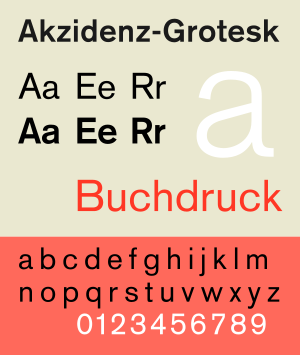
International Typographic Style
Encyclopedia

Graphic design
Graphic design is a creative process – most often involving a client and a designer and usually completed in conjunction with producers of form – undertaken in order to convey a specific message to a targeted audience...
style developed in Switzerland
Switzerland
Switzerland name of one of the Swiss cantons. ; ; ; or ), in its full name the Swiss Confederation , is a federal republic consisting of 26 cantons, with Bern as the seat of the federal authorities. The country is situated in Western Europe,Or Central Europe depending on the definition....
in the 1950s that emphasizes cleanliness, readability and objectivity. Hallmarks of the style are asymmetric layouts, use of a grid
Grid (typography)
A typographic grid is a two-dimensional structure made up of a series of intersecting vertical and horizontal axes used to structure content. The grid serves as an armature on which a designer can organize text and images in a rational, easy to absorb manner....
, sans-serif
Sans-serif
In typography, a sans-serif, sans serif or san serif typeface is one that does not have the small projecting features called "serifs" at the end of strokes. The term comes from the French word sans, meaning "without"....
typefaces like Akzidenz Grotesk
Akzidenz Grotesk
Akzidenz-Grotesk is a grotesque typeface originally released by the Berthold Type Foundry in 1896 under the name Accidenz-Grotesk...
, and flush left, ragged right text. The style is also associated with a preference for photography in place of illustrations or drawings. Many of the early International Typographic Style works featured typography
Typography
Typography is the art and technique of arranging type in order to make language visible. The arrangement of type involves the selection of typefaces, point size, line length, leading , adjusting the spaces between groups of letters and adjusting the space between pairs of letters...
as a primary design element in addition to its use in text, and it is for this that the style is named.
See also
- International style (architecture)International style (architecture)The International style is a major architectural style that emerged in the 1920s and 1930s, the formative decades of Modern architecture. The term originated from the name of a book by Henry-Russell Hitchcock and Philip Johnson, The International Style...
- HelveticaHelveticaHelvetica is a widely used sans-serif typeface developed in 1957 by Swiss typeface designer Max Miedinger with Eduard Hoffmann.-Visual distinctive characteristics:Characteristics of this typeface are:lower case:square dot over the letter i....
- Max BillMax BillMax Bill was a Swiss architect, artist, painter, typeface designer, industrial designer and graphic designer.Bill was born in Winterthur...
- Adrian FrutigerAdrian FrutigerAdrian Frutiger is one of the prominent typeface designers of the 20th century, who continues to influence the direction of digital typography in the 21st century; he is best known for creating the typefaces Univers and Frutiger.-Early life:Adrian Frutiger was born in Unterseen, Canton of Bern, as...
- Armin HofmannArmin HofmannArmin Hofmann is a Swiss graphic designer. Hofmann followed Emil Ruder as head of the graphic design department at the Schule für Gestaltung Basel and was instrumental in developing the graphic design style known as the Swiss Style...
- Richard Paul LohseRichard Paul LohseRichard Paul Lohse was a Swiss painter and graphic artist and one of the main representatives of the concrete and constructive art....
- Josef Müller-BrockmannJosef Müller-BrockmannJosef Müller-Brockmann, , was a Swiss graphic designer and teacher. He studied architecture, design and history of art at both the University and Kunstgewerbeschule in Zurich. In 1936 he opened his Zurich studio specialising in graphic design, exhibition design and photography. From 1951 he...
- Paul RandPaul RandPaul Rand Paul Rand Paul Rand (born Peretz Rosenbaum, (August 15, 1914 — November 26, 1996) was an American graphic designer, best known for his corporate logo designs, including the logos for IBM, UPS, Enron, Westinghouse, ABC, and Steve Jobs’ NeXT...
- Emil RuderEmil RuderEmil Ruder , Swiss typographer and graphic designer, who with Armin Hofmann helped to found the Schule für Gestaltung Basel and a graphic style known as the Swiss Style....
- Jan TschicholdJan TschicholdJan Tschichold was a typographer, book designer, teacher and writer.-Life:Tschichold was the son of a provincial signwriter, and he was trained in calligraphy...
Further reading
- Fiedl, Frederich, Nicholas Ott and Bernard Stein. Typography: An Encyclopedic Survey of Type Design and Techniques Through History. Black Dog & Leventhal: 1998. ISBN 1-57912-023-7.
- Hollis, Richard. Swiss Graphic Design: The Origins and Growth of an International Style, 1920-1965. Yale University Press: 2006. ISBN 0-300-10676-9.
- Müller-Brockmann, Josef. Grid Systems in Graphic Design. Niggli: 1996. ISBN 3721201450.
- Ruder, Emil. Typography. Hastings House: 191981. ISBN 0-8038-7223-2.

